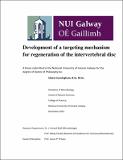| dc.contributor.advisor | Wall, J. Gerard | |
| dc.contributor.author | Cunningham, Claire | |
| dc.date.accessioned | 2015-03-16T17:11:26Z | |
| dc.date.available | 2015-03-16T17:11:26Z | |
| dc.date.issued | 2014-11-24 | |
| dc.identifier.uri | http://hdl.handle.net/10379/4902 | |
| dc.description.abstract | Degeneration of the intervertebral discs (IVD) is a leading cause of neck and low back pain. While its aetiology is poorly understood, it is known to begin in the central nucleus pulposus region, leading to degradation of the extracellular matrix and loss of the osmotic, and ultimately mechanical, properties of the IVD. Many current treatments for lower back pain alleviate the pain temporarily but do not restore disc function. Biological regeneration approaches under investigation include administration of matrix-mimicking scaffolds, cells and/or therapeutic factors. Cell-targeting strategies are likely to improve the delivery of therapeutic moieties due to the low cell numbers in the IVD. Single-chain antibody fragments (scFvs) that bind IVD cells were isolated for potential delivery of therapeutics to restore disc function. Neural cell adhesion molecule 1 (NCAM1) was identified as a potential cell surface marker of IVD cells. The most cell-distal domain of NCAM1 was cloned and expressed in the Escherichia coli periplasm. Phage display technology was used to isolate a human scFv against the recombinant domain by panning a scFv library on the immobilised protein. Binding of the isolated B5 scFv was confirmed by ELISA and the scFv bound cultured rat astrocytes, as well as bovine nucleus pulposus and annulus fibrosus cells in immunocytochemical studies. The scFv also successfully labelled cells in bovine spinal cord and six-month and two-year old bovine IVD sections by immunohistochemistry. Taken together, these results illustrate the NCAM1-binding potential of B5 scFv and support a role for the scFv in targeting therapeutics to IVD cells for regeneration of the intervertebral disc. It is anticipated that the described scFv will be employed for targeted gene delivery to IVD cells using scFv-functionalised nanoparticles. Antibody fragments can provide cell-binding moieties at improved cost, time, yield and functionalisation potential over whole antibodies and the work demonstrates the feasibility of the combined protein expression/phage display approach in the isolation of cell-binding antibody fragments for use in a wide variety of targeting and delivery applications. | en_US |
| dc.rights | Attribution-NonCommercial-NoDerivs 3.0 Ireland | |
| dc.rights.uri | https://creativecommons.org/licenses/by-nc-nd/3.0/ie/ | |
| dc.subject | Degeneration of the intervertebral discs | en_US |
| dc.subject | low back pain | en_US |
| dc.subject | Department of Microbiology | en_US |
| dc.subject | School of Natural Sciences | en_US |
| dc.title | Development of a targeting mechanism for regeneration of the intervertebral disc | en_US |
| dc.type | Thesis | en_US |
| dc.contributor.funder | Science Foundation Ireland | en_US |
| dc.local.final | Yes | en_US |
| nui.item.downloads | 1237 | |


